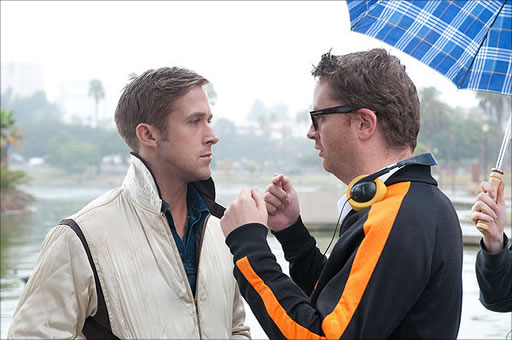Editors' Picks
| Film Review | "Drive" - Gritty Realism of a Film from the 1970s Through the Lens of the Stylized Modern Day By Nash Choudhury posted Oct 14, 2011, 18:09 |
In interviews, director Nicolas Winding Refn and star Ryan Gosling insist their latest film Drive is a violent version of the John Hughes classic Pretty in Pink. However, what the film most resembles is the gritty realism of a film from the 1970s through the lens of the stylized modern day. One could easily imagine a Steve McQueen or a Clint Eastwood circa Bullitt and Dirty Harry respectively taking over Gosling�s role as the mostly silent driver and yet, through the modern lens of Refn, there�s a vulnerability to Gosling that may not have been present had this movie been made in the seventies heyday of great gritty crime films.
Ryan Gosling plays a man we only know as Driver, a stunt driver for the movies who moonlights as a getaway driver for the Los Angeles criminal underground. That is until he meets Irene (Carey Mulligan) and her young son whose husband is soon coming home from jail. When he gets entwined into their lives things go from bad to worse putting everyone�s lives at risk including his own.
Albert Brooks plays the big baddie of the piece but instead of hamming things up as you would expect when a comic actor comes in to play the serious bad guy role, Brooks is genuinely menacing and frightening here. When watching Brooks� performance, the phrase killing someone with kindness pops to mind. While the character�s words and actions, at least towards the beginning, seem genuine and true, there�s something in Brooks� delivery and demeanor that lends his performance an intensity that becomes genuinely frightening as the film goes on. There�s something strange and off-putting in Brooks face in this film and it was only afterwards did I realize that he had actually shaved his eyebrows for the part. This is a perfect example of how a film should manipulate its audience without ever calling attention to it.
While it�s the unrequited love between Carey Mulligan�s sweet natured waitress and Ryan Gosling�s anonymous yet striking Driver that provides the important tragic spine to the film, what makes the movie most memorable are the quiet scenes of contemplation right before the sickening acts of violence and action. It�s the kind of action filmmaking that mainstream filmmakers seem to have either forgotten or intentionally ignore in today�s more equals better climate. It�s not so much the action scenes themselves that make great action movies (though a well staged and composed action sequence is incredibly important) it�s the moments in between and leading up to these sequences that provides the audience with the thrills and suspense that are mandatory for any good action film. Refn can proudly take up the mantle of being the art house answer to Michael Bay and his ilk, making action movies the way they should be.
Refn�s filmmaking is all about style as the substance of the film rather than taking one over the other. Rather than having large CGI set pieces and distracting the audience through loud noises, Refn goes to the rarely seen corners of Los Angeles and uses his camera, the environment around him, and some of the best use of eighties pop music and electronica I�ve ever seen to create indelible sequences of great romance, tragedy, action, and violence.
 About the Author: Nash Choudhury is a 25 year old graduate from Binghamton University with a BA in Creative Writing. He is currently a freelance writer with a passion for movies.
About the Author: Nash Choudhury is a 25 year old graduate from Binghamton University with a BA in Creative Writing. He is currently a freelance writer with a passion for movies.
